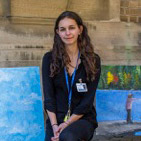From fainting to familiarity
“I was the kid who passed out,” says Rachel Strauss, describing her first experience in a trauma setting. She was in Grade 11 and taking part in Sunnybrook’s PARTY (Prevent Alcohol and Risk-Related Trauma in Youth) Program, a one-day course developed to increase injury and prevention awareness among young people. She and her classmates toured the trauma rooms and intensive care unit where they listened to paramedics speak about their work and watched videos of resuscitation procedures. “It really resonated with me and stayed in the back of my mind for a long time,” she says. Years later, when Strauss decided to try clinical research, she knew exactly what area she wanted to work in. “I wanted to go back to trauma and see if I could tackle it because it was hard for me before. I thought, ‘I’m not going to be afraid of trauma. It’s exciting and cool.’”
Tackle it she did. This is the second summer Strauss has spent working with Dr. Barto Nascimento, an associate scientist in the Trauma, Emergency & Critical Care Research Program at Sunnybrook Research Institute (SRI). As part of the D+H SRI Summer Student Research Program, she is completing a secondary analysis of a randomized controlled trial that compared two different blood transfusion strategies.
When a patient arrives at a hospital with heavy bleeding, physicians traditionally rely on lab tests to determine the best mixture of red blood cells, plasma and platelets with which to transfuse the patient. The goal is to stop the bleeding and prevent coagulopathy, a condition caused by prolonged or excessive bleeding in which blood fails to clot. The drawback of this approach is that lab tests take time, and as Strauss notes, “time is of the essence in trauma.”
In the second strategy patients are automatically transfused with a mixture containing a fixed 1:1:1 ratio of all three blood components. Giving a mixture with more plasma, however, could come with an increased risk of transfusion-related acute lung injury and the possibility of wasting a valuable resource that is in short supply.
The randomized controlled trial, which was led by Nascimento and conducted solely at Sunnybrook, found no difference in mortality between patients treated with either strategy. Strauss is digging deeper into the data to try to figure out why.
“We’re looking at the data and asking, in those first 24 hours, did [the transfusion] have an effect on coagulopathy?” she says. She is looking specifically at a protein called clotting factor V, which helps blood coagulate, and whether critically low levels of factor V in the patient’s blood is related to continued bleeding after the initial hemorrhage has been controlled. Preliminary results indicate that low levels of factor V could predict further blood loss after hemorrhage control.
In addition to her work with Nascimento, Strauss is working on separate projects with SRI trauma researchers Drs. Luis Da Luz and Homer Tien. She is also helping to recruit patients for a clinical trial and studying for the MCAT exam, an admission test for medical school. “I like it to be never a dull moment,” she says.
Her journey with Sunnybrook extends far beyond the trauma research she’s conducted over the past two summers. An avid artist, Strauss has painted three ceiling tiles in honour of Sunnybrook nurses who have passed away and drawn medical illustrations for some of the hospital’s patient pamphlets. “It’s really cool that I get to incorporate [art] into Sunnybrook,” she says. “I love working here. The fact that it’s the largest trauma centre in the country is just a bonus.”
Rachel Strauss received a D+H Summer Studentship Award.



